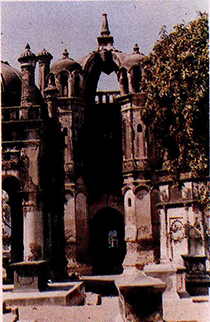Cemeteries
Introduction
The tombs in English, Dutch and Armenian cemeteries at Surat are reckoned among the most important historical monuments in the city. It is reported that there was so much competition between the Dutch and the English in Surat to impress upon the natives their importance and power that they put mausoleums instead of tomb stones. Many of these are so ridiculously large and ornamental resembling Muslim tombs rather than the ordinary tomb stones in Europe.
One of the tomb in the Dutch cemetery is quoted as unequalled among the structures of its kind (barring a few) in Europe. However, Mr. A.F. Bellasis who had given a detailed account of these monuments and their epitaphs in the Journal of the Royal Asiatic Society of Bombay for January 1861 was evidently apprehensive that within another fifty years or so the majority of these monuments, totally uncared for as they were in his time, would disappear.
Thanks, however, to Lord Curzon's solicitude for India's historical monuments, and to the efforts of the Archaeological Survey of India, established forty years after Bellasis wrote and which has under its charge a legacy of monuments and archaeological sites of national importance that these cemeteries in Surat are declared as protected monuments. In-spite of this, majority of these monuments are showing the signs of serious deterioration and it is feared that if measures to conserve them are not expedited the city would loose its historic memorials of the past.
A brief description of the distinguished architectural style of the few of the important tombs in the English, Dutch and Armenian cemeteries along with their historical background is presented here.
English Cemeteries
The English Cemetery
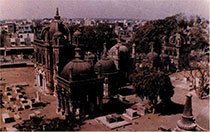 The English cemetery which is situated outside the city-wall (which was known as
'Alampanah') near the Katargam Gate reminds the visitor eloquently of many a famous
names in the historical narratives of the English factory at Surat who were the
significant persons in the political history of the city. As per the "Revised List
of Tombs and Monuments of Historical or Archaeological Interest in Bombay and other
Parts of the Presidency" published in 1912 there were about 19 tombs in the English
cemetery during that time, many of which are still existing. In addition to these,
there is a large number of simpler structures, and inscription slabs-over the graves
of less important persons. Few of the imposing monuments of this cemetery are described
here.
The English cemetery which is situated outside the city-wall (which was known as
'Alampanah') near the Katargam Gate reminds the visitor eloquently of many a famous
names in the historical narratives of the English factory at Surat who were the
significant persons in the political history of the city. As per the "Revised List
of Tombs and Monuments of Historical or Archaeological Interest in Bombay and other
Parts of the Presidency" published in 1912 there were about 19 tombs in the English
cemetery during that time, many of which are still existing. In addition to these,
there is a large number of simpler structures, and inscription slabs-over the graves
of less important persons. Few of the imposing monuments of this cemetery are described
here.
Mausoleum of Oxenden Brothers
The most imposing mausoleum in the English cemetery is that erected over the graves of those 'most brotherly of brothers' Christopher Oxenden and Sir George Oxenden. It is made of two cupolas, one of which being superimposed on the other. Christopher died in 1659, and a domed structure with four pinnacles at the comers, was erected over his grave. The English rendering of an epitaph in Latin, written by his brother and placed within it on a small slab is as follows:
Christopher's more famous brother, Sir George Oxenden, the President of the English factory, also died at Surat in 1669, being the victim of an epidemic that ravaged the town. He was deservedly popular among all classes of people by his very high character. As head of the factory and the more distinguished brother, a loftier and
more expensive cupola was raised in his honor above the tomb in which his and Christopher's bones were laid.
Distinct Features
This Oxenden monument is remarkable for the peculiarity of its upper dome, which represents an open cross. Its height and diameter are 40' (12.2m) and 25' (7.62 m ) respectively. The cupolas are supported by massive pillars and round their interiors are galleries ' reached by a flight of many steps. The translation of the inscription in Latin on a large marble slab inserted in the upper compartment of this mausoleum is as follows:
It has been reported that, his funeral was a great affair in Surat, and as the cortege passed by, the streets, balconies, and tops of the houses were so full as they could stand one by another. The Rev. Philp Anderson, in his book The English in Western India' says that 'the body of an Indian Viceroy might have found here a worthy resting place ; it is far too superb for the Chief of a Factory, and his brother who was only a subordinate.
The Tomb of Gerald Aungier
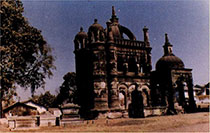 A grand structure, in close proximity to the mausoleum of the Oxendens, which
strangely
enough, has no original inscription in it, is generally supposed to be that
of Gerald
Aungier, President of the English factory at Surat. He was also Governor of
Bombay.
A grand structure, in close proximity to the mausoleum of the Oxendens, which
strangely
enough, has no original inscription in it, is generally supposed to be that
of Gerald
Aungier, President of the English factory at Surat. He was also Governor of
Bombay.
An inscription to the effect that the mausoleum contains the remains of Gerald Aungier was placed in the tomb as late as 1916 at the suggestion of Lord Curzon, who visited Surat for more than once during his viceroyalty and was a keen student of the early history of the English factory in Surat as the cradle of the British power in India.
Other Tombs
In addition to the tombs described above, there are other less historical tombs in this cemetery, some of which display the armorial bearings of the families to which the deceased persons belonged. Among the less important tombs are those of Henry Gary ( 1658); Bartholomew Harris, President (1694); James Hope, 'Chief for the William Andrew Price, Chief for the affairs of the British Nation and Governor of the Moghul Castle and Fleet of Suraf (1774). The English rendering of the Latin epitaph on the Tomb of President Harris and his wife Arabella is as follows :
Dutch Cemeteries
The Dutch Cemetery
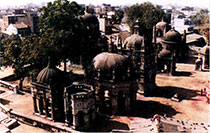 The Dutch as well as Armenian cemeteries at Surat are situated in a locality known
as 'Gulam Falia' near the mail road leading to Katargam Gate. The Dutch tombs are
of various sizes and shapes, but the one that excels all the rest in magnificence
is the grandiose mausoleum of Baron Adrian Van Reede and, is described here in detail.
The Dutch as well as Armenian cemeteries at Surat are situated in a locality known
as 'Gulam Falia' near the mail road leading to Katargam Gate. The Dutch tombs are
of various sizes and shapes, but the one that excels all the rest in magnificence
is the grandiose mausoleum of Baron Adrian Van Reede and, is described here in detail.
Mausoleum of Baron Adrian Van Reede
The tomb of Baron Adrian Van Reede, who was the Director of the Dutch Company in the Indies was intended to rival and eclipse that of the Oxendens in English cemetery. It consists of a double cupola of great size, with a gallery above and below, supported on handsome columns. This monument was formerly ornamented with frescoes, escutcheons, and passages from the Scripture, and the windows were filled with beautiful wood carving. There are three epitaphs in the monument, the one to Baron Van Reed being inscribed in a compartment on the wall opposite the entrance door, and reads as under:
The Dutch Admiral Stavorinus, who visited this graveyard in 1775 has described that the mausoleum of Van Reede 'excels all the others in largeness of dimension, elegance of architecture, magnificence of ornament, and richness of material'.Moreover, P. Anderson has reported about this monument as follows :
A Jovial Dutch-Man's Tomb
M. Jean de Thevenot, a French traveller, who was at Surat in 1666, records that during his stay in this city a tomb was being built for a President of the Dutch factory at the estimated cost of eight thousand Francs. He also mentions about an interesting monument in this cemetery over the grave of a person of some note who had been banished to India by the States-General of Holland. He was said to be related to the Prince of Orange. Since he had a great addiction to drink, in token of the same, a large stone cup had been placed on the top of the dome and other cups at the four corners of the tomb with the figure of a sugar loaf besides each. It is mentioned further that when the Dutch want to enjoy themselves they go there, make a hundred stews in these cups, and use other smaller cups to take what they have prepared out of the large ones, and then they drink it. According to John Ovington who was at Surat as Chaplain to English Factory in 1690, it was built by the orders of the jovial commander himself, for the entertainment of his surviving friends, 'who remember him there some times so much that they quite forget themselves.'
The writer of an article "Surat - its Past and Present" in Calcutta Review for 1848 describes this monument as the most discreditable of all the tombs in the burying ground, because of the ostentatious glorification of a failing which was so common among the European factors at the time.
The writer of an article "Surat - its Past and Present" in Calcutta Review for 1848 describes this monument as the most discreditable of all the tombs in the burying ground, because of the ostentatious glorification of a failing which was so common among the European factors at the time.
Other Epitaphs
Of the two other epitaphs hung on either side of that of Van Reede in the monument described above, one relates to the death in 1695 of the worshipful Lord Paulus de Roo', Commissary of the Dutch East India Company in Surat and along the Malabar Coast, and Governor Emeritus of the extensive island of Ceylon. The other tablet records the death in 1642 of the 'Chaste Lady' Magdalene Haijers, the wife of the Honourable Director Paulus Croocq and the death of Bastina Theodora Le Boucq, wife of the Lord John Schreuder, Director and Superintendent of the Dutch East India Company, in 1743.
The Armenian Cemeteries
The Armenian cemetery is situated adjacent to that of the Dutch. Though, the graves in this cemetery, arc bearing a large number of inscription slabs they have no super-structures raised above them as is the case in the English and Dutch cemeteries. The oldest epitaph is the one of Armenian verse over the tombstone of a lady named Marinas, the wife of the priest Woksan, who was a crown to her husband, according to the proverbs of Solomon. The date of her death is mentioned as 1028 of the Armenian era ( Christian year 1579).
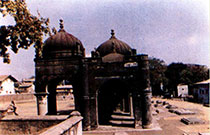 There
is also a beautiful mortuary chapel, but there is no date showing the year of its
construction. However, the same may be concluded from the tombstone over the grave
which is inside this chapel, bearing the date 1695. Its Amenian inscription is rendered
as under :
There
is also a beautiful mortuary chapel, but there is no date showing the year of its
construction. However, the same may be concluded from the tombstone over the grave
which is inside this chapel, bearing the date 1695. Its Amenian inscription is rendered
as under :
While nearly two hundred graves lie outside this chapel, it is the only tomb situated inside this building. It thus shows that the deceased must have belonged to a family of very high repute at Surat. He was the only son of Khwaja Phanoos Kalandar, an eminent merchant of Julfa and the acknowledged leader of the Armenian nationality in Persia and India. The records of the English East India Company in London also show that an important agreement between the company and the Armenian nation represented by this magnate, who is described as an Armenian merchant of eminency and an inhabitant of Isfahan in Persia was signed on 22 June 1688. It appears that the elder Phanoos settled down at Surat, and the body of his only son, who died there in 1695, was as a special privilege, in token of the high position held by his father, buried within the mortuary chapel in the Armenian cemetery in the city.
